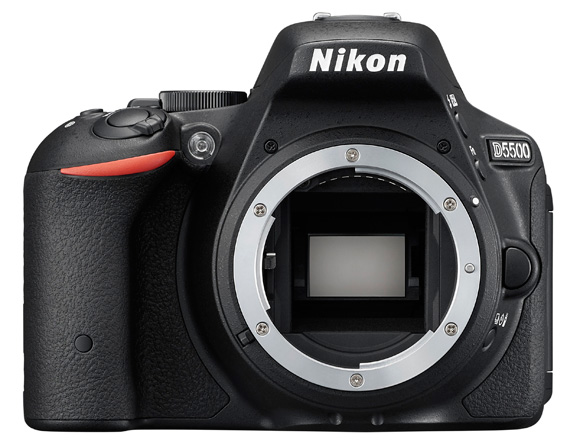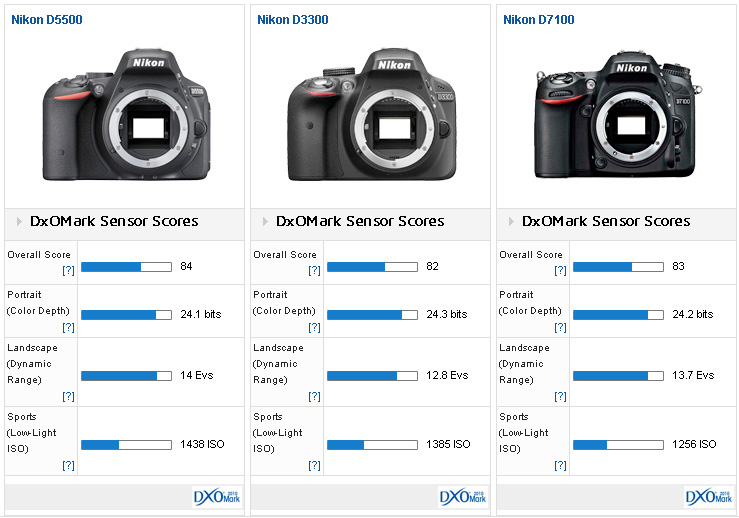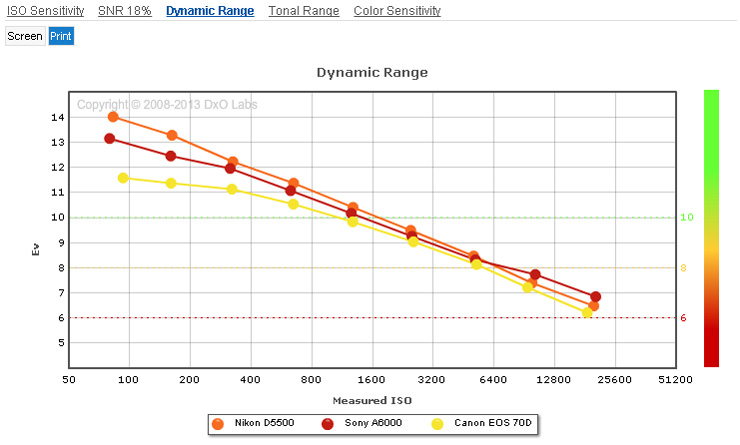Introduction
Specification and Features
Announced at this year’s CES, the latest update to the mid-range DX 5xxx series, the D5500 actually succeeds the D5300 (there was no D5400) and adds several refinements over that model. The D5500 is the first Nikon DSLR to feature a touchscreen rear panel. Like its predecessor, it’s a pull-out and reversible 3.2-inch 1,037 k-dot type display with a hinge located on the side rather than at the bottom, which makes it an attractive feature for both still and video capture.
Although the D5300 was the first Nikon DLSR to feature built-in WiFi and GPS, the D5500 drops the latter in favor of an optional accessory. Nevertheless, the new model adopts a different and more powerful EN-EL14a battery, with improved life up from a quoted xx shots to xxx. It also adds a couple of new picture controls for out-of-camera JPEGs and a few minor tweaks to the body shell design, with engineering plastic in the construction.
In every other regard, the D5500 duplicates the specifications of the previous model, including the AF module, EXPEED 4 processor, shutter, and other modules. Of interest to us here at DxOMark, of course, is the 24-Mpix APS-C format CMOS sensor, which like the D5300 before it has no OLPF (anti-aliasing filter) for optimal resolving power.
As a mid-range DX model, the D5500 is reasonably compact, measuring 4.5 x 2.6 x 2.2″ / 114.8 x 66.2 x 55.0 mm and weighing just 13.86 oz / 393 g with battery and SD card. It is available now at around $899.
Key specifications
- 24.2-Mpix DX-format CMOS sensor
- EXPEED 4 image processor
- No optical low-pass filter
- 3.2-inch 1,037k-dot vari-angle touchscreen
- Full HD video at up to 60fps (inc 24fps, but not in 720p) .Mov with H264 compression.
- Built-in Wi-Fi connectivity
Measurements: Nikon D5500: Excellent dynamic range
Achieving a DxOMark score of 84 points, the D5500 ranks high at 21st place in the DxOMark database overall and 11th place for all Nikon models, just one point in front of its predecessor, but still behind the studio-favorite full-frame Nikon D3Xs (88 points), which coincidentally has the same pixel count.
The D5500 has excellent color discrimination, with color depth measured 24.1 bits, putting it on par with other sensors found in Nikon cameras, such as the recently introduced and tested entry-level D3300. That’s not a bad thing either, as that model punches well above its weight. The dynamic range of 14 EVs at base is an excellent result, and better than the entry-level option. It’s typical now of the current crop of mid-to-high-range Nikon models, even if the low-light ISO score of 1438 ISO isn’t as high as any of the company’s current full-frame models, although that’s not unexpected.
Comparison 1: Nikon D5500 vs Nikon D3300 vs Nikon D7100: Low noise and excellent DR
Compared to the company’s entry-level model and the D7100 (which has recently seen an upgrade to the D7200), there’s very little between the sensor performances. In fact, Nikon has leveled the playing field among them, to the point that most general users should choose based on specifications and price alone.
Even though the as-yet untested D7200 sensor is likely to be similar in performance to the D5500, for the discerning user, if we look more closely at the underlying data, there are a few differences between them. If we look at the Full SNR logarithmic graphs at base (ISO 100), for example, rather than SNR at 18%, we can see that the D5500 has the lowest noise levels of the three. The D7100 has similar noise levels at ISO 200, but the D3300 doesn’t really catch up till ISO 400. That is reflected in the dynamic range, where the D5500 has a pretty substantial 1.2Ev advantage at base and just 0.3Ev over the D7100. The slight advantage also accounts for the marginal improvement in our Sports (Low-light ISO) scores, and is the highest ISO setting that allows a dynamic range of 9 Evs and a color depth of 18 bits.
Comparison 2: Nikon D5500 vs Canon EOS 70D vs Sony A6000: Class-leading noise and DR
With a DxOMark score of 82 points, Sony’s more accessibly-priced mirrorless A6000 — another model with a 24Mpix APS-C CMOS sensor — achieves a similar overall performance, but if we’re to criticize it at all, the sensor isn’t quite as efficient. Just like the D3300, it has slightly higher noise levels at low ISOs, which in turn limits the dynamic range. Although the Canon EOS 70D is the least accessible (and heaviest) of the trio, due in part to its intriguing Dual Pixel CMOS AF technology which allows continuous autofocusing during live view and video capture, with its higher maximum shutter speed (up to 1/8000th sec), weather-sealing, and 7fps burst shooting, it is arguably the closest model in the maker’s range to the D5500 for which we have data.
As with the Sony A6000, though, the EOS 70D can’t match the D5500 for noise at low ISOs. In fact, it’s some ways behind the Sony as well, despite having a slightly lower pixel count (20-Mpix) and in theory, larger photodiodes. While the individual sensels capture light and perform phase-detection AF, however, Canon hasn’t detailed how this arrangement works exactly. At high ISOs (1600 and above), the Canon is on par with both the Nikon and Sony, but the lower dynamic range (Landscape) and Low-light ISO (Sports) scores result in a somewhat disappointing overall DxOMark score.
Conclusion
Hard-core Nikon fans aren’t likely to find too much here to get excited about, especially as the company has traded the touchscreen LCD for the built-in GPS of the D5300. Now D5500 users will have to budget $250 extra for the GP-1 and have it take up the accessory shoe, or spend another $15 for the GP1-CL1 strap clip. Of course, you could possibly sync location data using the Wireless Mobile Utility app, but that’s another story. In terms of sensor performance alone, the Nikon D5500 is class-leading, and based on that and the feature set, it is an intriguing choice overall.












DXOMARK encourages its readers to share comments on the articles. To read or post comments, Disqus cookies are required. Change your Cookies Preferences and read more about our Comment Policy.